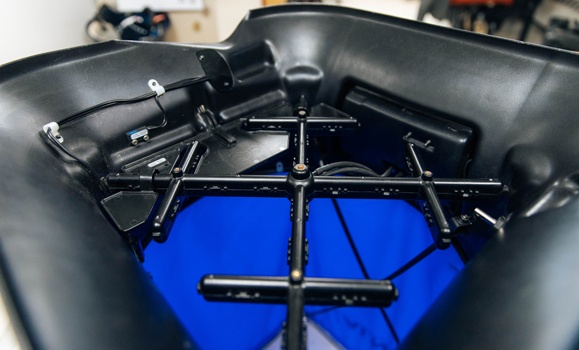In the early months of the COVID-19 pandemic, everyone was focused on cleaning: hand sanitizer supply, heightened surface cleaning and everyone washing their hands like never before.
That work never stopped ‚ÄĒ you‚Äôll see a continued emphasis on cleaning, hand washing and widely available hand sanitizer on campus this fall. But we‚Äôve also all spent the past year reading about aerosols, droplets and air particles, reflecting that COVID‚Äôs primary mode of spread is airborne, typically through close person-to-person transmission.
That makes ventilation a key part of AVĺ„ņ÷≤Ņ‚Äôs multi-layer safety plan. Efforts to improve air flow within classrooms, research labs and other spaces on campus ‚ÄĒ when combined with masks, vaccination protocols and all the other layers in Dal‚Äôs plan ‚ÄĒ is part of the complete picture to keep the Dal community healthy and safe this fall.
‚ÄúWe‚Äôve had a team working tirelessly on this project for months and months now,‚ÄĚ says Darrell Boutilier, director of operations with AVĺ„ņ÷≤Ņ Facilities Management. ‚ÄúIt‚Äôs a small team, but it‚Äôs a very skilled and experienced team, who has managed to do a lot of work in a relatively short period of time.‚ÄĚ
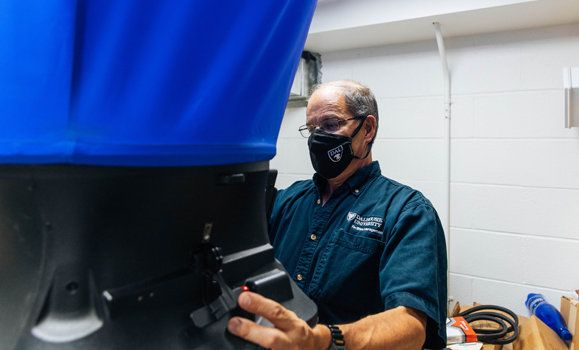 Terrence Conrad, Instrument Shop working foreperson. Őż
Terrence Conrad, Instrument Shop working foreperson. Őż
That team has been led by Kyle MacKenzie, who joined AVĺ„ņ÷≤Ņ as a utilities manager in 2019 but was embedded on campus for four years prior as a contractor with Johnson Controls, working on ventilation and control systems. In his work with Johnson, he serviced about 60 clients across the Maritimes, and prior to that he was an operator at the Queen Elizabeth Hospital in Charlottetown, running 30+ ventilation units with different requirements.
‚ÄúCompared to other facilities I‚Äôve been at, I‚Äôd say it‚Äôs very good,‚ÄĚ says MacKenzie, when asked to rate the condition of Dal‚Äôs ventilation prior to all this work. ‚ÄúI think we expected a lot more failures and issues, to be honest. But this was a great opportunity to give attention to the [air exchange] units and make sure everything was up to snuff.‚ÄĚ
Setting the standard
AVĺ„ņ÷≤Ņ‚Äôs ventilation strategy was guided by current engineering best practice, as well as COVID-specific guidance from ventilation and facilities groups including ASHRAE (American Society of Heating, Refrigerating and Air-Conditioning Engineers) and APPA (Association of Physical Plant Administrators) in accordance with provincial and national Public Health guidelines. Őż
The core of the strategy: to reduce the risk of infection from inhalation of COVID-19 by utilizing campus HVAC systems to improve air exchange rates, minimize recirculation of air and improve air filtration.
This work began in research labs, during the ‚ÄúReturn to Research‚ÄĚ process last summer as the university worked to safely bring as many of Dal‚Äôs researchers as possible back to their necessary lab spaces. In total, over 165 research spaces were assessed.
‚ÄúMost are already well ventilated, as they have air supply systems and fume hoods required for the research itself,‚ÄĚ explains Boutilier. ‚ÄúWhere we found deficient airflow and had to make improvements or provide guidance, it was usually not in the labs themselves but in the shared office spaces often attached to the labs. But in general, most of our labs are very well ventilated.‚ÄĚ
Into the classrooms
After research spaces, the next top priority for the Facilities team were the classroom spaces that, come September 2021, would be welcoming the majority of students and instructors back to in-person learning.
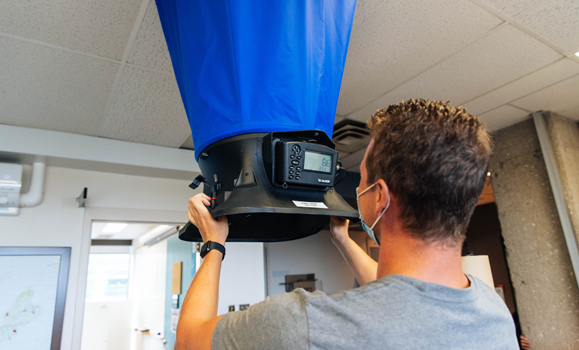
Mitchell Claridge, millwright apprentice
‚ÄúIf you look at ASHRAE, which is really our bible for this sort of work, we had quite a high percentage of classrooms that were already near the upper threshold for high-quality ventilation,‚ÄĚ says MacKenzie. ‚ÄúWe ended up focusing most of our attention on the ones that were older.‚ÄĚ
Indeed, Dal‚Äôs classroom spaces are in a wide range of buildings ‚ÄĒ from newly built spaces like the Emera IDEA and Richard Murray Design Buildings all the way to the Forrest Building, which back in the late-19th century constituted the entire university campus. In total, MacKenzie‚Äôs team assessed ventilation in over 600 classroom and learning spaces. Of those, 53 were identified where air flow rate criteria were not met and remedial measures had to be taken.
Improving airflow
‚ÄúThe approach to improve ventilation really varied by the space,‚ÄĚ MacKenzie continues. ‚ÄúIt could be as simple as rebalancing the airflow in the space, or it could be installing 50 feet of ductwork. And where none of that work was feasible, we used HEPA units.‚ÄĚ
Those are filtration units for spaces that lack modern ventilation systems. (One is pictured below.) ‚ÄúThey have a 99.97% filtration rate. They really take every ounce of particulate out of the air and are recommended by ASHRAE in situations where you can‚Äôt access outside air.‚ÄĚ
As a general practice, the team‚Äôs goal was to ensure that classroom systems exceeded a minimum target of three air changes per hour ‚ÄĒ and do whatever they could to get that number even higher, closer to four-to-six air changes per hour.
Now, air changes alone don‚Äôt tell the whole story, says MacKenzie. ‚ÄúI‚Äôm against setting one threshold because it‚Äôs not that simple.‚ÄĚ For example, of the few classrooms remaining with slightly lower air change rates, some have high ceilings ‚ÄĒ meaning more air space in general ‚ÄĒ while a couple others are in new buildings with some of the most high-tech air systems on campus that bring in high volumes of fresh external air (which is prioritized in industry code standards for COVID).
Classroom tips for the fall
- Natural ventilation is one of the best ways to add more airflow to even well-ventilated spaces. Faculty and instructors in classrooms with windows will see signage encouraging them to open windows where weather permits, particularly in the fall.
- ŐżIf your classroom has a HEPA filter unit, please don‚Äôt try and adjust the unit yourself. You‚Äôll see contact information for Facilities Management on the device if you have concerns about noise or device quality. FM reception will be happy to help.
But overall, the AVĺ„ņ÷≤Ņ community can take confidence in just how much air exchange will be occurring in classrooms this fall.
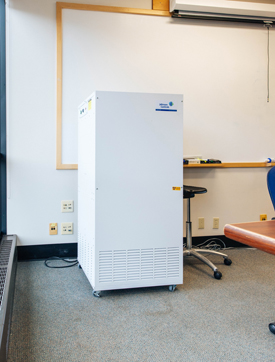 ‚ÄúOver 80 per cent of our classes now have more than six air changes per hour,‚ÄĚ says Boutilier, ‚Äúand we expect by the time we‚Äôre done this work in the coming days that 98 or 99% will be more than four.‚ÄĚ
‚ÄúOver 80 per cent of our classes now have more than six air changes per hour,‚ÄĚ says Boutilier, ‚Äúand we expect by the time we‚Äôre done this work in the coming days that 98 or 99% will be more than four.‚ÄĚ
Strategies for offices and other spaces
For obvious reasons, the team’s top ventilation priorities have been the classroom and lab spaces which bring together the most people in a shared space at one time.
To ensure that other spaces also received guidance, Boutilier and colleague Craig Arthur from the Environmental Health and Safety team have been doing building tours with administrators, providing information on building systems and guidance for how best to manage particular spaces of concern.
‚ÄúWe‚Äôve probably walked through every single building in the past couple of months,‚ÄĚ says Boutilier. ‚ÄúWith most offices, it‚Äôs a single person occupying the primary workspace space, and there are often windows for extra natural ventilation when available. So they‚Äôre significantly lower risk than shared spaces, but we‚Äôve still made time to work with building administrators to try and educate them on strategies people can use to manage those smaller spaces.‚ÄĚ
A team effort
The arrival of students and instructors back to classrooms this September represents a big milestone for the ventilation team.
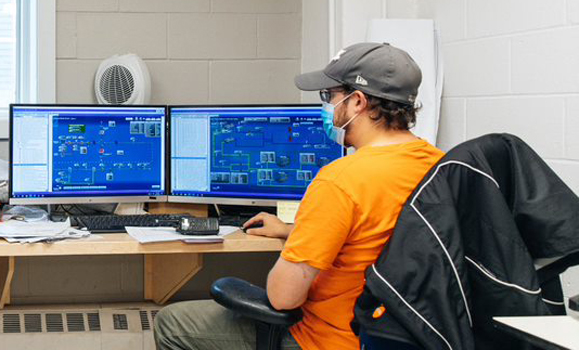
Jamie Sparrow, instrumentation mechanic, examines the computer control that supports many campus ventilation systems.
‚ÄúIt‚Äôs been a staggering amount of work,‚ÄĚ says MacKenzie. ‚ÄúThe core of our team was about three people, with other people cycled in as needed. It feels like we covered all five-and-a-half million square feet of space on campus, given how deep we were into every building.‚ÄĚ
In addition to MacKenzie’s team, Boutilier credits the external partners involved in the work as well, including Matheson Air Balancing and sheet metal contractor Frank Cowie.
But for all the effort, it’s been a rewarding experience working to improving the safety of spaces across campus.
‚ÄúWe‚Äôve had a chance to bring some team members into this work and really develop their skills,‚ÄĚ says MacKenzie. ‚ÄúOne guy wants to go back to school and do instrumentation now that he‚Äôs doing all this. So there‚Äôs some really good moments from all this.‚ÄĚ

